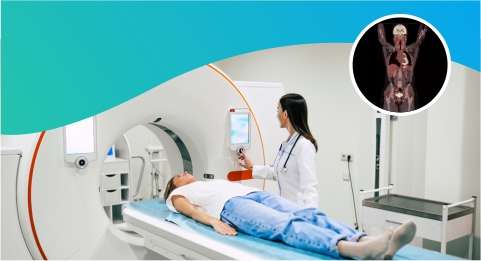
MRI stands for Magnetic Resonance Imaging. This medical imaging technique uses computer-generated radio waves and specifically-created magnetic field to create detailed images of targeted tissues and organs to identify the...
MRI stands for Magnetic Resonance Imaging. This medical imaging technique uses computer-generated radio waves and specifically-created magnetic field to create detailed images of targeted tissues and organs to identify the problematic area and intensity of the diseases. During the test, magnetic field realigns water molecules in body for a limited period. Accordingly, radio waves make aligned atoms to generate signals. These signals are then utilized to develop cross-sectional MRI images.
What MRI Can Detect?
MRI proves extremely helpful to detect several types of problems in Brain, Spinal Cord, Heart, Blood Vessels, Internal Organs, Bones & Joints and other areas of the body. This medical imaging technology is basically performed to evaluate the condition of:
• Organs of Abdomen & Chest (including Kidneys, Spleen, Pancreas, Adrenal Glands, Biliary Tract, Liver, Heart, etc.)
• Pelvic organs (including Uterus, Ovaries in females, Prostate Gland in males, Bladder and Reproductive Organs)
• Lymph Nodes
• Blood Vessels
Doctor basically uses MRI to diagnose and monitor situation of:
• Tumors in Pelvis, Abdomen or Chest
• Fetus of a pregnant woman
• Issues related to Liver like abnormalities in Pancreas and Bile Ducts
• Malformation of Blood Vessels
• Inflammation of vessels (Vasculitis)
• Ulcerative Colitis and Crohn's disease
• Congenital Heart disease
What is the Procedure of MRI?
MRI is an OPD procedure so you do not need to be in hurry in anyway. Technologist will give all instructions before starting the test. You can also ask any question before going inside the large tube on a narrow table. You are expected to lie in one position throughout the test. On the basis of your condition and feedback, technologist can also use straps to keep you still.
This test includes multiple runs. Some of the sequences last for several minutes. During each run, you will hear different types of sounds.
Your technologist or medical staff can also insert intravenous Catheter (IV line) into a vein of hand or arm if your exam uses contrast material.
MR Imaging essentially requires you to lie inside the machine for a limited period. Whereas, technologist will work on a computer from a safe distance (may be outside the room). However, you can talk to him through a microphone (given inside the machine).
If your test requires contrast material then technologist will inject it into your intravenous line (IV) after initial scanning. Consequently, more images will be captured following the injection.
Technologist will then check the images, once the test is complete, to ensure whether more images are needed.
After the test, technologist will remove IV line and ensure proper dressing over insertion site.
MRI is a 30-50 minutes long procedure. So, remain calm to create better report.
How to Prepare for MRI
MRI is a safe OPD procedure. So, you do not need to prepare much before going for the test. However, it is essential to discuss all points with the technologist if you have any kind of health complication. Doctor most of the time uses ‘Gadolinium’ mri test as contrast material for some patients. Talk to your doctor if you have asthma or certain type of allergy. You may need specific medicines before using contrast material.
You are also suggested to follow below mentioned points before undergoing the test:
• Change to loose clothes (hospital gown is a good option)
• Remove dental work, if any
• Empty your pockets
• Leave eyewear, watch, jewellery items outside
• Do not carry mobile phone or any other gadget, toy inside
• Lie in one position throughout the test
These items and frequent movements disturb radio waves to cause blurred images. Kindly follow all tips to generate better reports.
What will I Experience during the Procedure?
MR Imaging requires you to lie in one position inside machine while coils generate the radio waves. During the imaging process, you will hear different types of sounds. Remain calm! They are safe and do not cause any harm. You are also advised to talk to your doctor if you are Claustrophobic. Technologist might take additional precautions to make you feel safe and relaxed.
Who Needs to Avoid MRI?
However, MR Imaging proves completely safe for everyone but pregnant ladies specifically during the first trimester should avoid undergoing the test until necessary. First three pathology labs months are very critical stage of pregnancy as fetus’ organs forms and contrast agents, if used, might cause highly considerable issues to compromise upon certain terms.
Benefits
• Noninvasive medical imaging technique
• Does not involve exposure to radiation
• Effectively work to evaluate a broad range of issues in Brain, Heart, Vascular disease, • Kidney and more
• Helps to assess Biliary System
• Perfectly detect abnormalities of targeted areas
Risks
However, MR Imaging is safe and do not pose any health risk. But, you need to know about some nominal risk factors including but not limited to:
• Carelessness towards safety guidelines
• Sedation
• Contrast material
• Strong magnetic field
• Nephrogenic Systematic Fibrosis (Gadolinium related complication)
What to do after MRI test
Wait for sometime once the test is done as technologist will take few minutes to check the quality of images and handover report. Collect report and consult doctor to know the results. Make sure, you are fully awake to drive safely to home. If not, then wait for little more time and contact any dear to accompany you for home.
Who will analyse the MRI report?
Only a trained radiologist or physician can analyse the MRI report to evaluate your situation and decide about the future course of treatment. Always consult the certified one to stay protected against all kinds of unpredictable issues.









